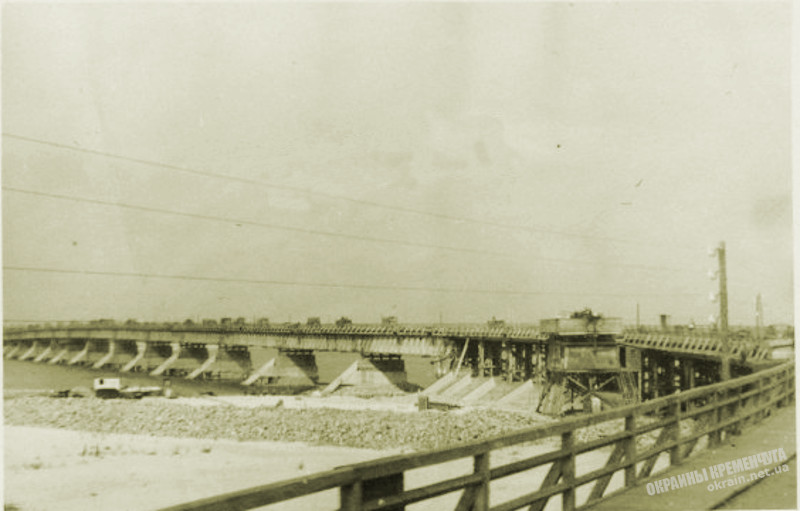Author: Petr Potapenko
By the beginning of September, units of the 297th division held Kremenchuk. But for the division, there was a threat of encirclement because the Nazi troops upstream and downstream broke through the front and crossed the Dnieper River.
On September 9, 1941, on Tuesday, the 297th division left the city of Kremenchuk after a 30-day defence.
In the autumn of 1941, the Germans lifted the collapsed bridge truss and set it in place. The bull support was not destroyed, only the “pillows” of the support and the upper part of the rectangular stones on one of the corners of the bull were demolished into the water.
Around the bridge, the Nazis arranged a restricted area and pulled barbed wire in two rows. There were no trees in the area, not even weeds. The approaches to the bridge were heavily guarded.
During the occupation of Kremenchuk, the Germans managed to build a wooden bridge across the Dnieper with the hands of captured Red Army soldiers. In Kremenchuk, there were several camps for prisoners of war, mainly in the mountainous part. And one camp was located in a quarter on the corner of Proletarskaya (now Heavenly Hundred) and Ukrainian streets, on the territory of the Mirror Factory. There were two-story brick buildings, a spacious courtyard, on which were packed piles of rectangular glass for mirrors. Several thousand prisoners of war were kept in these premises. It was they who built the wooden bridge on the First Zanasyp.
By the beginning of winter, they levelled the construction site (most of this area was sandy), made an entrance to the banks of the Dnieper, the Germans brought a lot of wood of various species. At the end of 1941, prisoners made parts for the bridge from wood, hammered oak piles into the bottom of the Dnieper with special devices – “women” (after all, oak does not rot in water, but only grows stronger, an ax cannot be cut). Support piers were cast from cement on these piles.
When all this was prepared, they began to build the roadway of the bridge in the winter of 1942. Tractors and tractors brought finished wood parts and metal fasteners across the ice. The winter was very strong, there were 40-degree frosts, ice up to 1 meter thick, and a lot of snow fell. Many prisoners died from the cold.
We, children from our yard and many children from Zanasip, went with bags and sledges to the bridge to collect wood waste for fuel. The German sentries did not touch us, because we picked up all the wood to the thread, and the Germans did not have to remove construction debris. But when the prisoners of war were driven to and from work, the sentries shouted: “Kinder, century, century!”, And we fled. Adult civilians were not allowed to the bridge.
Then I noticed how the flooring of the bridge was made – herringbone-shaped parquet.
By the spring of 1942, the Nazis opened to traffic on the constructed wooden bridge. Mostly cars and sometimes horse-drawn vehicles travelled along this bridge. But the flood was such that the bridge was flooded. The bridge was low.
The Nazis made a mark of the flood level on a rock near the river station “On April 5, 1942”, but it was the April water level, that flooded the floor of the wooden bridge. And already in May, the water level in the Dnieper rose so much that it flooded the entire bridge, only the railing was visible.
During the battles for the liberation of Kremenchuk and the retreat of the Nazis, the wooden bridge was destroyed – the runs of the above-ground part were burned, and the surface runs were blown up. It is difficult to say with certainty who destroyed the wooden bridge – either the Germans or our planes.
Now from the German bridge, there are only bulls-supports, six from the Kremenchuk side and one from the Kryukovskaya.
The fate of the former wooden bridge is also a landmark of historical memory, which reminds us of the events of the war in the city of Kremenchuk from 1941-to 1943.
After the wooden bridge failed, the Nazis quickly built a second pontoon bridge upstream of the railway bridge (the first pontoon bridge was built even when the wooden bridge was intact). With three bridges – railway and panton – most of the Wehrmacht troops managed to transport military equipment to the right bank, and then the Germans blew up the railway bridge. The pontoon bridges were destroyed by our Soviet aircraft, but it was already too late, the enemy troops managed to cross over to the other side.
During the retreat, the fascist Sonderkommandos blew up everything, from the railway station to the bridge. They laid pyroxylin bombs every few meters of the track (they were in such a hurry that they did not even have time to set fire to all the explosives laid under the tracks), they blew up the railway bridge that crossed the passage from Shevchenko Street to First Zanasyp. But not all managed to destroy: the tunnel survived. At the last moment they blew up the railway bridge on the right bank: two runs lay in the water, and the third seemed to rear up. The other eight spans stood straight, as if on a shoelace. All ten bulls survived.
Source: Book: “Kremenchuk. Three bridges across the Dnipro and their share 1872-1949. Petro Potapenko 2011 pic

